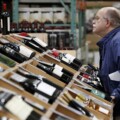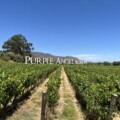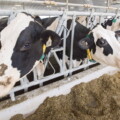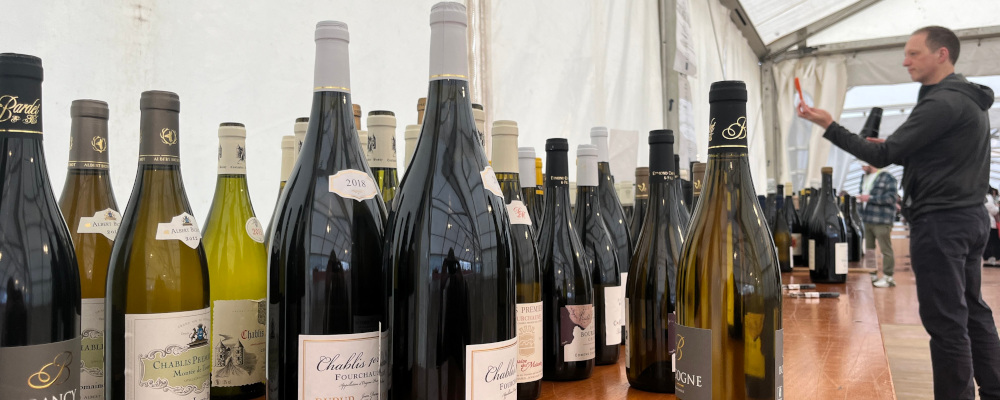If every wine region in the world got its wish, would it be to be la Bourgogne? Probably. The money’s pretty good. But, should they? Is la Bourgogne (sometimes referred to as “Burgundy”Because the vignerons of la Bourgogne showed me exceptional hospitality, and plied me with some very excellent wines at a dinner early in my recent visit in the charming cathedral city of Auxerres, I promised to call their region and its wines by its proper French name when I wrote about for the trip they hosted me on. To be fair “Bourgogne” is what is printed on the labels of the wine, so I understand why they wish to popularize the proper name. Also, the French word for the colour Burgundy is “Bordeaux,” so…) really where emerging wine regions want to go? Is the Côtes d’Or really just a long stony ridge of golden handcuffs, where conformity is the norm and the creativity of winemakers is stifled by dreams of €300-a-bottle release prices?
It’s crass to bring up the subject of money and commerce when discussing a craft—if not an art form—that regularly encompasses a vigneron’s life’s work. I regularly do, though, because it’s always there. The first consideration a consumer makes when buying a bottle or a case of wine is the price. When I meet a neighbour in the local liquor store and they ask me for a recommendation, my first question back is, “How much are you willing to spend?”
My participation in this year’s Grands Jours de Bourgogne, as a guest of the winemakers’ syndicate le Bureau Interprofessionel de Vins de Bourgogne, put this instinct on its head. Once I got used to being in a room with, for instance, a few hundred open bottles of Pouilly-Fuissé, the idea that wine is a business would magically fade away. In a good year I would consider myself lucky to have just one of these bottles open on the table in front of me on more than one occasion. But after a few sips, luxury can become commonplace pretty quickly.

Empires that don’t expand inevitably collapse. As the prices for the Grands, Premiers, and even Villages Crus continue to rise, so does investment in vineyards that were only recently considered at the margins of la Bourgogne. If you see Irancy (think red Chablis) on a wine list, you’re in the hands of a savvy sommelier and have the opportunity for at least a high quality-to-price ratio experience, if not an actual bargain. Same goes with the whites from St. Aubin or anything from the craggy Hautes-Côtes de Beaune.
Meanwhile, along the Côtes d’Or, the winemakers confound greenhorn dégustateurs de Bourgogne like me. I tasted a dozen 2022 Pinot Noirs in a row in Gevrey-Chambertin with a slight variance on clean and raspberry notes. I decided that resistance was futile, admitted that I was a simple man, and surrendered to the idea that the place itself, at only 400 odd hectares (a bit more than half the average size of a farm in Saskatchewan), had its own taste.
The Bordelais and the Bourgignons can fight it out as to who invented the idea of terroir. Each in their own way has exploited it beautifully. I stopped asking winemakers in Bourgogne about their elevation for the 2022 vintage because they kept giving me the same answers. The variance was really only in what one might do (which for all intents and purposes means how much new oak) to a Grand Cru versus a Premier Cru, and so on down the quality pyramid. The wine was meant to taste like the field, not the cellar, and the recipes were mostly fixed.
And why would anyone screw around with a recipe that works? If a Master of Wine expects a particular taste of place, why would anyone not give it to them? Across France, the invigilators of the cahier de charges, the rule books that strictly dictate how a wine must be made to hold the status of an appellation, must look at Bourgogne with envy. The vignerons hold the line, and as a consumer you can be confident that a given bottle of wine from the fields surrounding a particular village somewhere in between Dijon and Lyon will taste like it’s supposed to.
This is the dream of ambitious wine regions, though few come close to achieving it. Brunello di Montalcino is pretty close, though the occasional producer still goes heavy on the oak. Most wine tastings or trade shows run on a bell curve, with a few exceptionally good and bad producers. It is striking to go to three or four tastings in a day where the quality and consistency of character of the wines are flatlined on a high plateau. I found myself taking longer at the tables I visited, free from the anxiety that I was missing out on the one big discovery at the next table. I could take time to appreciate the wines in sequence, almost as a totality.
Of course, it could be that the rebels and outliers might just not show up to the Bureau’s tastings, or bring their off-piste wines to them. In Chablis a long line formed around the table of the Young Turk, Clement Lavallée, whose organic, biodynamic wines skirt around the term of art “natural.” But for all of their minerality, this young man’s Chardonnay had more in common than difference with the ones across the aisle on the tables of the big négociant houses. Chablis is Chablis, and the thought of the word should make the mouth water a bit like it does when we think of lemons.
Mavericks make good copy, and the wine media (present company included) is always looking for a rebel. If the winemaking rebel is also “legendary” or “iconic,” then it’s even better. The cult of the auteur is alive and well in wine writing (and its wealthier cousin, marketing). But there is a quieter poetry when winemakers work in concert to present their terroir in a voice that’s more in harmony than not. C’est bon, c’est typique.
Recommended for You

Malcolm Jolley: Need a date-night drink? French Northern Rhône wines are worth the investment

Malcolm Jolley: Keeping the California Cab Sauv on the shelf? Here’s what patriotic wine-loving Canadians can drink until Trump’s trade war is over

Malcolm Jolley: Whether it costs $20 or $200, wine has never been better—here’s why

Malcolm Jolley: Wine-tasting your way through Chile? Check out these must-visit wineries




